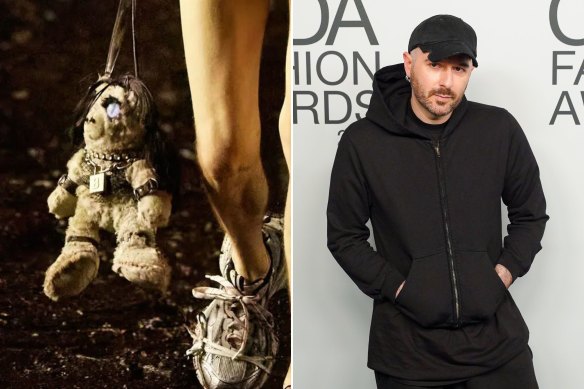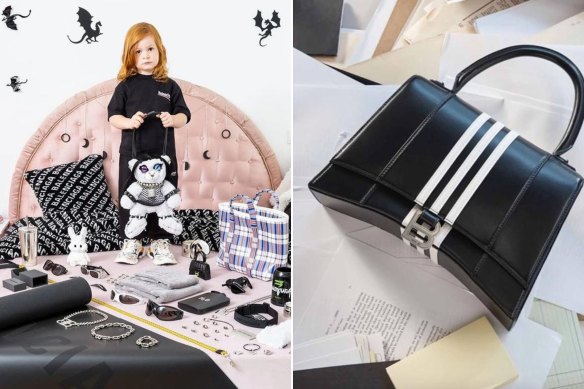This was published 2 years ago
The Balenci-saga sheds light on fashion’s dark side
If it wasn’t for a teddy bear handbag Balenciaga designer Demna (his last name Gvasalia was dropped last year) would have received the Business of Fashion Global Award to the sound of clapping Cartier rings at Soho Farmhouse in England on Thursday.
The award, which recognises “an extraordinary member of the international fashion community” and has been presented to Stella McCartney, British Vogue editor Edward Enninful and Virgil Abloh, was withdrawn. The reason? The teddy bar handbag was decorated with BDSM attire and carried by a child in a Balenciaga advertising campaign.

A BDSM teddy bear handbag on the runway for Balenciaga and the label’s creative director Demna, at the CFDA Awards in 2021.
“Children” and “BDSM” should never be used in the same sentence, let alone the same photograph, which was part of Balenciaga’s “Gift Shop” campaign. The Balenci-saga continued with copies of US Supreme Court documents relating to child pornography spotted in another campaign, beneath a $4900 handbag.
Other images from the campaign, with no incriminating material, feature model Bella Hadid, French actress Isabelle Huppert and Nicole Kidman who posted an image to her Instagram account days before the scandal erupted.
“Advertising is about getting attention,” says Dr Lauren Rosewarne, a popular culture expert at the University of Melbourne. “So I feel a bit dirty even commenting on this story because this is ultimately what Balenciaga wants – in discussing it we’re validating that the brand is relevant, cutting-edge and buzzy.
“The Balenciaga campaign is overtly targeting adults with the use of children in provocative situations. The revolting nature of the campaign comes from the nod to child porn with the company having some very sketchy plausible deniability.”

The controversial advertisement featuring children now removed by luxury label Balenciaga and its Spring 2023 campaign image with a copy of 2008 US Supreme Court document in relation to child pornography.Credit: Balenciaga
The latest apology from Balenciaga for the advertisements which have now been removed, follows a statement from Kim Kardashian, temporarily distancing herself from the brand for which she has modelled.
“We strongly condemn child abuse; it was never our intent to include it in our narrative,” was part of statement posted to the Balenciaga’s Instagram account.“The two separate ad campaigns in question reflect a series of grievous errors for which Balenciaga takes responsibility.”
“We could have done things differently.”
Strict guidelines are in place for child models working in Victoria and NSW according to Bianca Birnbaum, National Talent Manager for Bettina Talent Agency, which operates a children’s modelling division.
“Employers must send over their creative briefs, storyboards, a risk assessment and a call sheet to the relevant child employment body, to be approved before employment commences,” Birnbaum says.
The agency also operates in Queensland, where Birnbaum says there are fewer restrictions. “The rules in other states are less strict, however we do ask our clients to send over photos of what the kids would be asked to wear and tell us as much information about their shoot as possible, before we even send them suggestions of models.”
“We also advise parents that they must stay and supervise their child on set at all times. Their child is never to be out of their sight – not even if they need to move the car, get a coffee, go to the toilet.”
“Something like the Balenciaga shoot could slip through the cracks in some states if the producers are not up front about the details of their shoot or if a parent doesn’t speak up on set. But it is less likely here in Australia.”
For Rosewarne, the Balenciaga campaign is the latest example of fashion’s troubled relationship with children, stretching back to the infamous 1980 Calvin Klein jeans campaign featuring a15-year-old Brooke Shields saying : “Do you know what comes between me and my Calvins? Nothing.”
“Balenciaga is just one of infinite brands that have pushed the boundaries of taste and acceptability this way,” Rosewarne says. “They’re not even the first to bring children and sex together in a campaign.”
In an interview with US Vogue last year Shields said that at the time she was unaware of the innuendo.
“At 56, I can go back and look at the camera and say: ‘Oh well they’re zooming in and yeah it’s sort of on my crotch area and then it comes to my face. Like okay,’” she said. “But sex has sold since the dawn of time.”
“On the one hand, I don’t think you could get away with a lot of what I did in the eighties now – but by the same token, so much more is done now than what we would’ve ever dreamt of doing.”
Former child model Cheyenne Tozzi who appeared on the cover of Harper’s Bazaar aged 13 and went on to appear on the covers of Vogue, GQ and Cosmopolitan has condemned the Balenciaga shoot.
“The protection of children is paramount at all times,” Tozzi says. “It goes without saying that these images are grossly unacceptable. Although there are multiple third parties involved, it is inevitably the responsibility of the brand to sign off on the collateral.”
Rosewarne says concerns about the welfare of the children featured in the campaign should not be escalated because of the classification by many online commentators of the advertisements featuring children carrying the BDSM teddy bear bags as child pornography.
“In discussions of sexualisation of children we need to understand that this is an adult interpretation of what’s happening,” she says. “For the children in the photographs it’s going to be a modelling job like any other. They’re just holding teddy bears.”
“I don’t think this single campaign necessarily necessitates any guidelines beyond what currently exist.”

Kim Kardashian walked in the Balenciaga show on July 6, 2022 in Paris.
The Georgian designer Demna currently remains as creative director at Balenciaga which is owned by French luxury conglomerate Kering, also the owners of Gucci and Alexander McQueen. The company does not release revenue information for Balenciaga, but HSBC estimates the fashion house received about €1.76 billion ($2.75 billion) in sales in 2021.
People have been fired for less. In 1997 then Balenciaga designer Josephus Thimister was fired by the brand’s former owners after some members of the audience at a runway show walked out because the music was too loud.
If Demna stays it is the latest temperamental mood swing in the fashion industry. Model and content creator Tanja Gacic sees a shoot for Vogue Japan in 2001 she took part in as a 20-year-old, with photographer Terry Richardson, who faced allegations of sexual assault in 2017, as a reminder of fashion’s challenges. In the shoot Gacic posed with teddy bears.
“Watching this Balenciaga saga unfold reminds me just how far removed from reality my industry is sometimes, how myopically attuned to a different value system where being perceived as cool, well dressed and important tops any moral or ethical compass,” Gacic posted to Instagram.
“I don’t see this as luxury fashion,” she said by phone. “It’s abhorrent. We need to evaluate where fashion is going.”
Make the most of your health, relationships, fitness and nutrition with our Live Well newsletter. Get it in your inbox every Monday.